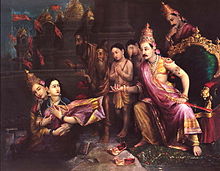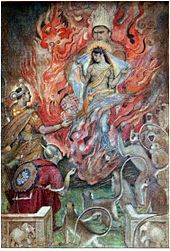Sita (mythology)
Sita ( Sanskrit सीता Sītā f., Literally “furrow”) is the goddess of agriculture in Hinduism , a daughter of the earth goddess Bhudevi and the wife and female counterpart ( Shakti ) of Rama , the hero of Ramayana . While Rama is considered the seventh avatar of Vishnu in many versions of the epic , Sita is considered to be the avatar of the goddess Lakshmi (the latter is considered Shakti to Vishnu).
Meaning of sitas
Sita is still considered the epitome of the faithful, good, chaste, pure woman, obedient daughter and the ideal image of a morally irreproachable, submissive, devoted wife (pativrata) . In the epic Ramayana, written in Sanskrit, and in the subsequent Rama cult, she was almost exclusively defined by her husband, for whom she gave herself up to the point of self-sacrifice. Here the desires, the well-being and the reputation of Rama determined all actions and thoughts of Sita. Her fate is inextricably linked to that of her beloved husband; for Sita, Rama is the center of her life. In her the loving devotion, which allows no separation from the revered husband, condensed into the ideal image of the ideal devotion to God, whose mediator, follower and admirer she is.
Sita in the Vedas
Sita is already mentioned in the Vedas, where she is still a relatively insignificant deity. There she was considered the goddess of plowed fields, agriculture and field crops. In the imagination of ancient India , she symbolized the action of the plow and thus implied the need for a fertility-bringing male power, which she enlivened and awakened. She was an earth goddess associated with growth and vegetation and embodied the womb of the earth. She was considered the wife of Indra . She was called when four furrows were drawn during a sacrificial ritual. Boiled rice and barley were offered to her in an offering cake. The importance of the fertility goddess is also clearly felt in the Ramayana, in which the goddess is surrounded by animals in the forest and even plants react to them.
myth
The king of Mithila , Janaka , finds the child Sita in a furrow while plowing and accepts her as his daughter. He only wants to give the grown up as a wife to those who manage to draw Shiva's great bow . In contrast to the other kings, Prince Rama apparently succeeds in this effortlessly, and the Prince of Ayodhya and the daughter of Janaka marry full of mutual love .
Some time after Rama married the beautiful Sita, she voluntarily accompanies him into exile in the woods, where they lead a simple life in a hermitage for fourteen years. The demon king Ravana wants to kidnap Sita, and with the help of a trick he succeeds: The demon Maricha transforms into a beautiful gazelle. Sita falls in love with this dazzling animal and asks her husband to catch it for her. While he is chasing the gazelle, the demon calls for help in Rama's voice. Lakshmana immediately rushes to help his brother Rama. Ravana uses this time, approaches the young woman in the form of a mendicant monk and forcibly abducts her to his kingdom in Lanka . There he asks Sita to become his wife; she refuses with disgust. He gives her two months to think about it, otherwise he wants to kill her. Sita resists all his advances. Her outer beauty is said to have faded during this time, as a woman can only develop her true beauty by the side of her husband. Inwardly, however, Sita is beautiful as before and only with Rama uninterrupted with every thought. Through his court magicians, Ravana creates the head of Rama, which he shows Sita to make her believe that Rama is dead. But even at this moment Sita is only looking to blame herself and wondering what she might have done wrong. although she is not aware of any guilt. If not in this life, then maybe she was guilty in her last life. It never occurs to her that Rama might have done something wrong.
With the help of Hanuman , Rama succeeds after a while in saving his wife. However, Sita refuses to let Hanuman save her, even when he shows her the ring of Rama as an identification mark. She does not want to be touched by any other man and, moreover, does not want to deprive her husband of the opportunity of the honor and glory of her salvation. So Rama frees herself and kills Ravana. However, he doubts her loyalty and claims that he did not free her out of love, but only to save the honor of his family: "Which man of honor would submit to his passion and take back a woman who lived in someone else's house?" Sita protests her impeccable way of life, and in her desperation she subjects herself to an ordeal by fire , which acts as a divine judgment : She mounts the blazing pyre, but because of her innocence is returned to her husband by the fire god Agni , who puts her in his arms. Both go back to Ayodhya, where Rama is crowned king with Sita at his side.

In the last book of the Ramayana, which was added later, the murmuring of his people forces Rama to cast off the meanwhile pregnant Sita again. She goes to the woods for 15 years, where she lives in the hermitage of the sage Valmiki and gives birth to her husband's twin sons Kusha ("grass") and Lava ("cut"). Years later, Rama, hunting in the forest, meets the two of them and recognizes them as his children. In spite of his love for her, however, he asks Sita, under the pressure of his subjects, in the presence of the protesting gods, to take an oath and to prove her innocence. Once again she protests that she never thought of another man. But then she angrily asks Mother Earth ( Bhūmi ) to open her womb for her. Rama protests, but in vain. A throne with snakes appears and Sita disappears into heaven. Rama then hands over the rulership to his sons and is united with Sita in heaven.
In the popular version of Tulsidas , the Ramayana ends with a happy ending and Rama and Sita are reconciled at the end.
literature
- David R. Kinsley: Indian Goddesses - Female deities in Hinduism. Insel, Frankfurt / M. 1990, ISBN 3-458-16118-X : Sītā , Chapter 5, pp. 95-114
- Rachel Storm: Encyclopedia of Eastern Mythology. Reichelsheim 2000, ISBN 3-89736-305-4 , page 160: Sita
- Anneliese and Peter Keilhauer: The Imagery of Hinduism. The Indian world of gods and their symbolism. DuMont, Cologne 1986, ISBN 3-7701-1347-0 .
Web links
Individual evidence
- ↑ for the following in essence: David R. Kinsley: Indian Goddesses - Female deities in Hinduism. Insel, Frankfurt / M. 1990, ISBN 3-458-16118-X : Sītā , Chapter 5, pp. 95-114
- ↑ Sita . In: Jan Knappert: Lexicon of Indian Mythology. Heyne Verlag, Munich 1994, ISBN 3-453-07817-9 , pp. 284-286
- ↑ Sita . In: Gerhard J. Bellinger : Knaurs Lexikon der Mythologie . Munich 1999, ISBN 3-8289-4154-0 , p. 460

